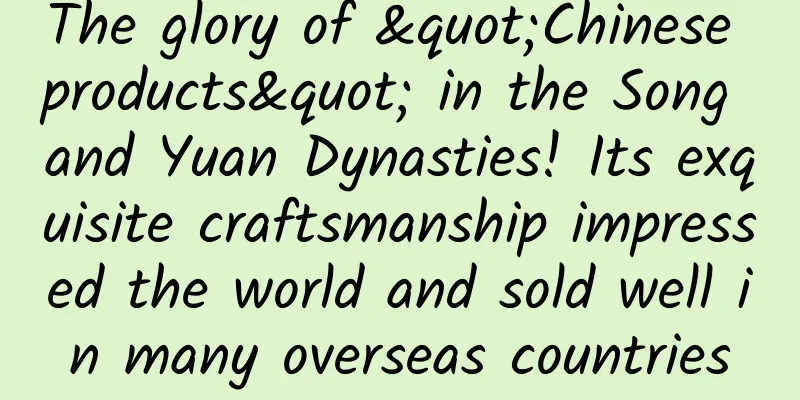The glory of "Chinese products" in the Song and Yuan Dynasties! Its exquisite craftsmanship impressed the world and sold well in many overseas countries

|
The lotus-petal-patterned bowl from the Song Dynasty Longquan Kiln has a deep belly, curved walls, and a ring foot. The inner wall is covered with cracks, and the outer wall is carved with lotus petals. The patterns are clearly carved and the lines are smooth. The glaze color changes from green to dark brown, which is generally believed to be caused by the ferrous oxide (FeO) content in the glaze exceeding 5%. Longquan Kiln is a famous celadon kiln in the Song Dynasty. The kiln site is located in Longquan City, Zhejiang Province. After the Song Dynasty, it was under the jurisdiction of Chuzhou, so Longquan Kiln is also known as Chuzhou Kiln or Chu Kiln. Longquan is famous for producing celadon in history. According to research, the birth of celadon began in the Han Dynasty. The quality of porcelain is the best in Yue Kiln in Zhejiang. Influenced by Yue Kiln, Ou Kiln and Wuzhou Kiln, plum green and powder green porcelain appeared after the middle of the Southern Song Dynasty. The plum green glaze layer is moist, clear and transparent, and the glaze color is verdant, but the glaze thickness is uneven, and there is glaze flow. Influenced by the style of official kiln porcelain in the late Southern Song Dynasty, thin-bodied and thick-glazed objects were praised. At this time, the glaze layer of Longquan Kiln was moist and mostly opaque. Its decorative techniques include carving and pasting. Longquan Kiln combined southern techniques with northern arts, and formed its own unique style by adding changes and improvements to the formula of body and glaze, the method of glazing, the design of shapes, and the decorative arts. On the other hand, the developed water transportation during the Song and Yuan dynasties was conducive to the development of foreign trade and also stimulated the production of Longquan Kiln porcelain. The Longquan County Chronicles records that "there are many porcelain kilns on both sides of the Oujiang River, with fireworks facing each other, and porcelain ships on the river coming and going." The main production area of Longquan celadon is located in Dayao Village, Xiaomei Town, Longquan City, Zhejiang Province. Among them, Jin Village, adjacent to Dayao, is an important production area of Longquan celadon, and radiates outward to the entire Longquan porcelain production area including Dayao. Longquan is located in the upper reaches of the Oujiang River, Minjiang River, and Qiantang River. Longquan porcelain reached Wenzhou, Ningbo and other ports through the Oujiang River, and spread to countries along the Maritime Silk Road. Among them, Wenzhou Port was one of the important ports for the export of Longquan kiln in ancient times. Wenzhou's maritime trade activities became more active in the Northern Song Dynasty. Wenzhou set up the Shibowu in the Southern Song Dynasty, and the Shibosi in the early Yuan Dynasty began to manage various overseas trade affairs. Zhao Ruoshi's "Records of Foreign Countries" is a book that studies overseas transportation and trade in the Song Dynasty. It is an important document in the history of Sino-foreign relations and an important work on the export of Chinese porcelain in the Song Dynasty. The book records the overseas distribution of Chinese porcelain, including the "celadon and other trades" and "blue-and-white porcelain trades" between my country and Southeast Asian countries. The book was written in the Southern Song Dynasty, when Longquan celadon was exported in large quantities, so the "celadon", "Chu porcelain", "blue-and-white porcelain" and so on in the book should refer to Longquan celadon. Since modern times, a large number of Longquan celadons have been unearthed in surveys of seas and sites around the world. In 1976, an ancient shipwreck was discovered on the seabed of Sinan, South Korea, and a large number of Longquan celadons were found on the ship, including bowls, high-footed bowls, bowls, saucers, plates, washbasins, jars, pots, bottles, boxes, medicine grinders, inkstone drippers, etc. for daily use, as well as bottles, stoves, flower pots, flower vases and Bodhisattva statues for display. In addition, the Blake shipwreck in the Philippines discovered in 1991, the Jabala shipwreck in Indonesia discovered in 1997, and the Bakao shipwreck in Indonesia discovered in 1999 all carried Longquan celadons dating from about the 12th to the 15th century. Chinese porcelain from the late Tang Dynasty to the Ming and Qing Dynasties was unearthed in Fustat, Mombasa, Malindi Coast and other areas in Africa, including a large number of Longquan kiln porcelain. A large number of Longquan celadons are also collected in the Topkapi Palace in Türkiye. Starting with the archaeological excavation of the Fengdongyan kiln site in Dayao in 2006, a joint archaeological team consisting of the Zhejiang Provincial Institute of Cultural Relics and Archaeology, the School of Archaeology and Museology of Peking University, the Palace Museum, and the Longquan Celadon Museum has been conducting continuous archaeological surveys, excavations, and research in the Longquan area, and has achieved important results. In 2009, the traditional firing techniques of Longquan Celadon were included in the Representative List of the Intangible Cultural Heritage of Humanity. Longquan kiln products seem to be a microcosm of an era. They retain traces of time and have traveled through hundreds of years to come before us, taking us to explore the prosperity of the Maritime Silk Road, witnessing the exchanges of maritime civilizations, and are also the crystallization of the wisdom of our ancestors. References Zheng Jianming, Xie Xiying, Zhou Guanggui. Brief report on the investigation of the Jincun celadon kiln site in Longquan, Zhejiang Province[J]. Cultural Relics, No. 5, 2018. Shen Jun. Porcelain from the Longquan Kiln of the Yuan and Ming Dynasties found in Africa[J], Archaeology and Cultural Relics, No. 2, 2016. Xiang Kunpeng. A brief analysis of the Longquan celadon unearthed in Southeast Asia: overview of the site, periodization and related issues[J], Southeast Culture, No. 2, 2012. |
<<: The V-2 rocket that landed on the wrong planet
>>: Was global warming first proposed by astronomers?
Recommend
Is it my hair that I'm losing? No, it's probably diamonds!
“A diamond is forever.” Diamonds are highly sough...
Mi fans spend more than 6,000 yuan a year to buy more than 1,000 mobile phone themes
Editor’s Note: Seeing such a willful Apple fan is...
Giant konjac, welwitschia orchid, sea coconut... you can see these exotic plants without going abroad
END Tadpole's original work, please indicate ...
NIO co-founder: We have a good relationship with JAC, and NIO car deliveries will start soon
"NIO's delivery standards are good licen...
The reason why there are so many mosquitoes has been found. Does the virus attract mosquitoes by regulating skin bacteria to produce "mosquito attractants"?
Great scientific discovery! Mosquitoes can actual...
Drones are now popular, how can we develop them into large-scale commercial use?
The road to commercialization of drones: Is it re...
Daqing SEO Training: Is it really reliable to pay for SEO after seeing the results?
Doing a good job of website SEO optimization can ...
NSA: Play a sound to hack your phone
Powerful smartphones hold too many secrets of thei...
OLED dark room tear LCD TV: black beats the color of the real youren
The TV industry, which is used to being calm, has...
Why are Western countries so concerned about facial recognition technology?
Facial recognition technology is now prevalent in...
Luckin Coffee community operation skills!
After Luckin Coffee was suspended and delisted, i...
Going inside rocks to explore the scientific mysteries of fluid inclusions
For many years, the academic community has been p...
Tennis elbow doesn't just affect tennis players, but also barbecue chefs? Explanation of lateral epicondylitis
Author: Yao Shiyi, postdoctoral fellow at Ruijin ...









